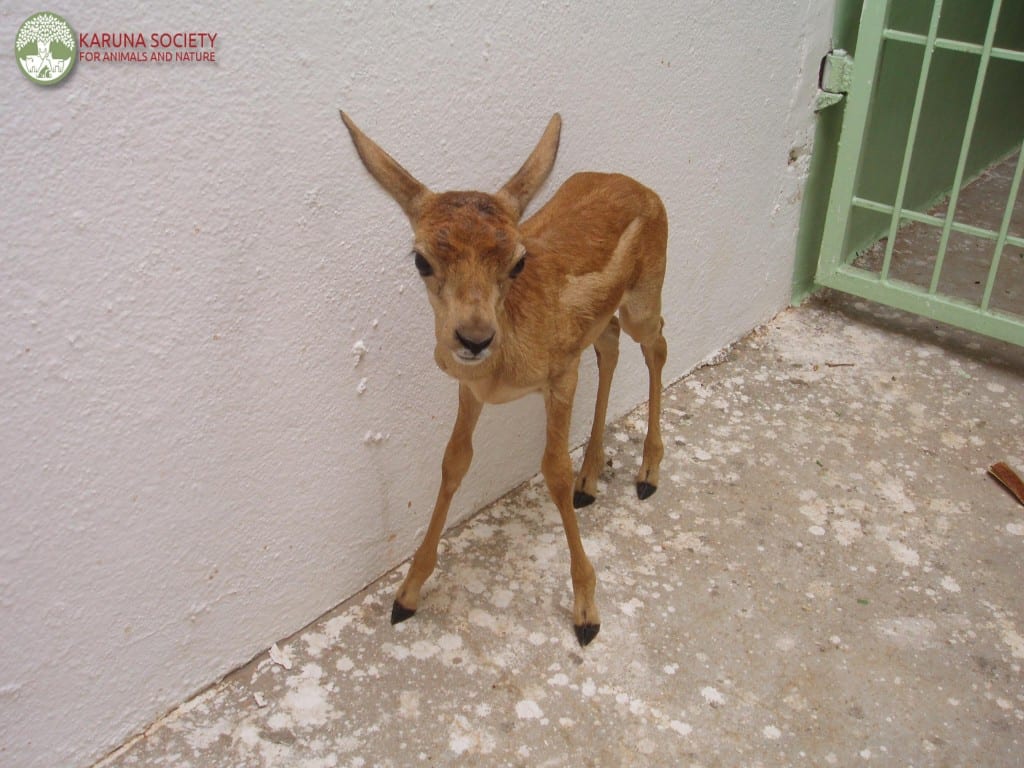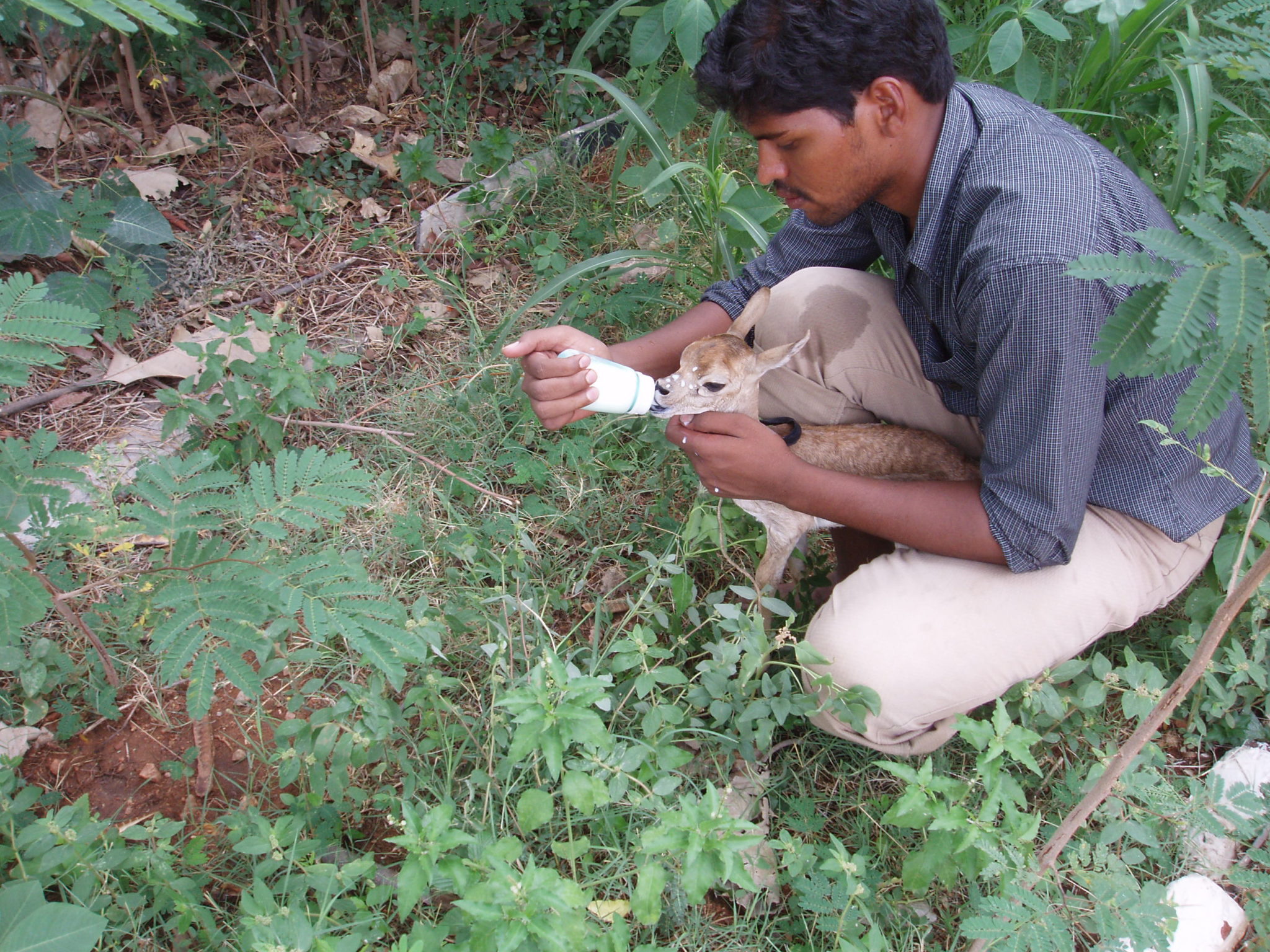All out war apparently declared on deer and other wildlife: what the hell is going on?
AN OPED BY RUTH EISENBUD
While major media in the United States and Britain are suddenly busy stoking up the fires against wildlife, in countries like India, where a non-Judeo-Christian tradition of respect for animals predominates, the treatment is often vastly different
In INDIA: A baby deer rescued by Karuna Society, now safe and sound, with nothing to fear!
 Ramping UP for the Great Deer Crusade of 2014
Ramping UP for the Great Deer Crusade of 2014
“Earlier this week, CBS did a very biased and one-sided presentation of the up-coming deer slaughter… shame on CBS reporters for such poor investigative journalism, for listening only to the very voices that are backing the killing, and not checking “their” facts, or doing the proper reserach on alternatives. The USDA is in the wildlife killing business and has to keep thier “killers” busy, to justify their salaries. The bit about donating meat to pantires is a sham, since most of the that meat will never be eaten…” —Zelda Penzel
• As reported by Jennifer McLogan in Federal Sharpshooters May Move In On Long Island Deer, the die seems to be already cast.
To justify their rapacious hunger to dominate and destroy any living being, labeled as ‘trespasser’, the enforcers of dominion have contrived statistics that fail to portray a realistic assessment of deer as an integral part of forest ecology. They raise hysterical claims of disease and pestilence, destruction of the forest, destruction of crops, as they label the deer a plague on mankind. Every holy war must have its plagues. This is the way of the semitic religions in their never ending quest for supremacy over animal kind and nature, over human trespassers and over each other. These three religions have convinced themselves that survival depends on scapegoating enemies, especially when the number of followers is on the decline. What better way to rev up membership (i.e donations), than by rallying around a common enemy. This time the enemy is a friendly animal, that co-exists peacefully with its habitat and with mankind – the deer. Next time it might be another animal to justify increased funds for the morally bankrupt department of wilderness services or it might be the mosque down the street, the synagogue on the corner or a sikh temple in Oak Creek, Wisconsin.Anyone who understands the vicious, duplicitous nature of this impending genocide, must look within, to decide if it is possible to remain in and provide moral or financial support to the animal phobic terrorist religions of dominion. These three religions combined: Judaism, Christianity and Islam are responsible for unspeakable, immeasurable animal suffering, since the mandate of dominion was first invoked five thousand years ago.
“Genesis 9:1-3 ‘The fear and dread of you shall rest on every animal of the earth, and on every bird of the air, on everything that creeps on the ground, and on all the fish in the sea; into your hand they are delivered. Every moving thing that lives shall be food for you; and just as I gave you the green plants, I give you everything.’”
This latest chapter in the never ending holy war against animalkind is fully backed by all the forces of dominion of a christian nation: hunters, wildlife services, government officials, the media, tyrannical religious doctrine and the sanctimonious religious leaders who raise a ruckus, when their tribe is threatened by verbal or real violence, yet show no empathy or compassion for the animals they condemn with the righteous fervor of a moral imperative. Some political leaders, such as Mayor Bloomberg of NYC, make light of the violence they support. While commenting on a goose call he ordered, he mocked it in a tone reminiscent of the sadism of nazi-speak::
When reason fails…
Eloquent, articulate and intelligent rebuttals have been issued by those who have seen beyond the cruelty of the judeo.christian tradition. Despite the best effort of the the holy warriors of dominion to inculcate in them the fear and dread so cherished by this tradition, these individuals understand the nature of compassion, that it is based on respect for the lives of both animals and men:
https://www.greanvillepost.com/2013/12/09/time-magazine-weighs-in-on-the-hunting-issue-disgracefully/
Responses to the news of the upcoming holocaust, from locals in the affected area have attempted to reason with the merry band of killers with pleas for common sense and compassion., as indicated by this sample of responses:
Lyme disease carriers come from & are spread by numerous feral & domestic sources particularly dogs, cats, mice, raccoons, ground hogs, squirrels, possums, skunks, birds, moles, rabbits etc… If Lyme disease was as much a problem as proponents of this wreckless proposal make it out to be, no one would be living here.
Allowing the notorious Wildlife Services to perform this task is outrageous. One of the most corrupt, venal, savage & incompetent government agencies in American history. They get laws repealed with a mere wink & a handshake to local politicians who allow our neighborhoods to be turned into a war zone. Apparently Wildlife Services is now spreading their sick carnage to the east where they can fleece the public even more. Remember, if they aren’t killing they’re not making any money. They’ve been slaughtering our wildlife in the west for decades & now see a great opportunity to increase their savagery by jumping on the now popular deer killing bandwagon. This ruthless rogue agency should be disbanded & held accountable for its crimes, not invading our neighborhoods with lethal weapons maiming, torturing, killing & leaving a bloody trail all over the eastern portion of Long Island.
In closing, before you complain about deer being a nuisance, remember, you destroyed their habitat, to build your own. Long Island politicians do not allow this to happen…
Hunters: What makes some men derive pleasure from killing a defenseless creature?

What if the measure of a man were instead based on protection, care and comfort for the weak
rather than the “divine right” to commit mayhem and violence against non-human beings?

WHAT IF…?
What if religion, political figures, government agencies such as wilderness services and religious leaders were on the side of the animals. What if it were against the law to order a cull of any animal? What if religion taught:
"For there is nothing inaccessible for death.
All beings are fond of life, hate pain, like pleasure,
shun destruction, like life, long to live. To all life
is dear." —Jain Acharanga Sutra.
—Jain Acharanga Sutra
This is not a fantasy, but a realizable possibility where dominionist religious doctrine has not infiltrated the mainstream view of animals. How different it is in India, where ahimsa informs the prevailing view of man and his relation to nature and animal kind; where Wilderness Services cooperates with animal organizations to protect, rescue and rehabilitate wildlife The following is an example of a deer rescued by wilderness services, then given medical care and respect at the Karuna Society Sanctuary, then released to the wilderness, when fully recovered: http://www.karunasociety.org/spotted-deer-recoverss
Spotted Deer Recovers from a Leg Injury and is Released Back into the Wild
 In July, a young spotted deer was brought in by the forest department. Her leg was deeply infected, inflamed and paralyzed. The chances of recovery at this stage were minimal. We started immediate treatment, and the infection seemed to heal, but the left foot was still not functioning.
In July, a young spotted deer was brought in by the forest department. Her leg was deeply infected, inflamed and paralyzed. The chances of recovery at this stage were minimal. We started immediate treatment, and the infection seemed to heal, but the left foot was still not functioning.
With further exploration we found two deeper wounds that went down to the bone. These wounds took five months to heal. After one year, fully recovered, this beautiful spotted deer was released back to its original habitat with the help of the forest department officials. The wildlife doctor from Wildlife Trust of India is still amazed that the deer survived.
What if those of us who care for protection, rescue and compassion over culls, hunting and slaughter were to take a stand against the religions that encourage the latter. What if we were to say no more – We will not tolerate your desecration of the sanctity of life for the sake of preserving archaic, violent doctrine. What if we were to finally break the ties with religions that are in direct opposition to the values of the compassion we hold dear. What if we were to say we will not support your cruelty, no matter how you try to get around it with slick phrases such as ‘the dominion of love’. There can be no love where slaughter is a holy right. The myth of the good shepherd must finally be laid to rest and with it the cruelty of dominion.
“It is the essential characteristic of a wise person that he/she does not kill any living being.
One should know that non-killing and equality of all living beings are the main principles of [a good] religion”—Jain sutra
ABOUT THE AUTHOR
Ruth Eisenbud is a veteran animal rights activist.
_________________________________
Nauseated by the
corporate media?
Had enough of their lies, escapism,
omissions and relentless manipulation?
Send a donation to
The Greanville Post–or
But be sure to support YOUR media.
If you don’t, who will?
Commentary: Women are fastest growing group of outdoors participants
Prefatory Note by Natalie Jarnstedt
 Hunters are decreasing in numbers, nationally and in more states than not, so they have been preying on young kids for youth hunts, and “independent”, “strong” women to take up the slack, They never use “kill”, but euphemisms like take, harvest, bag, remove, down…. (you name it!.) They see no problem with publishing sanitized cruelty, making the carcass look life-like, yet would never show reality of blood trickling from their mouths, blood at entry wound of gunshot or arrow (conveniently removed and hidden), with smiling or grinning killers proudly holding up the carcasses….
Hunters are decreasing in numbers, nationally and in more states than not, so they have been preying on young kids for youth hunts, and “independent”, “strong” women to take up the slack, They never use “kill”, but euphemisms like take, harvest, bag, remove, down…. (you name it!.) They see no problem with publishing sanitized cruelty, making the carcass look life-like, yet would never show reality of blood trickling from their mouths, blood at entry wound of gunshot or arrow (conveniently removed and hidden), with smiling or grinning killers proudly holding up the carcasses….
Field & Stream has an ad that local sports shops can use to sell their killing wares, making it really patriotic to kill animals, with camo-clad, armed women and men, military-style, defending us from those dangerous terrorist animals out there. Preying on patriotism, Homeland Security style, it is now heroic to kill defenseless animals.
The family that kills together, stays together, eh?
Non-consumptive outdoor activities actually bring more money to states than hunting, yet they very cleverly imply that hunting is the only outdoor activity…
See: Find the entire “Women in the Outdoors” survey at www.southwickassociates.com. SICK, SICK, SICK!
I corresponded with a newspaper editor in Oregon a few years ago, complaining about printing trophy photos of a hunter with a mountain lion, sanitized to look life-like, asking why bloody reality couldn’t be depicted – he said that people would be turned off by blood and gore… no shit, Sherlock! How do they think the animals died, by hypnotism?
http://m.youtube.com/watch?v=vdvMMKFC7vA&desktop_uri=%2Fwatch%3Fv%3DvdvMMKFC7vA
Women are fastest growing group of outdoors participants
October 26, 2013
For more than a decade, we’ve been hearing about declining outdoors participation — particularly in hunting, particularly among young people.
But beneath the headlines, data show the fastest-growing segment of outdoors users — including in hunting, including the young — is comprised of women.
More than a quarter of all freshwater anglers are women, and while the percentage of female hunters is lower, their numbers are growing.
“Many people may be surprised to learn the traditional view of the outdoors person is changing. But to anybody who hunts, fishes and shoots, the presence of women on the water, in the woods and at the range is anything but new, and certainly not surprising,” said Rob Southwick, president of Southwick Associates.
The Florida-based polling company he formed in 1989 is paid to gather data for studies commissioned by the U.S. Fish and Wildlife Service, state wildlife agencies and nonprofit environmental groups, and compile market data for sportfishing and other outdoors-related industries.
Noticing raw data in many unrelated polls showing a trend in rising outdoors participation among women, Southwick took the unusual step of culling and repackaging data on women from three years of studies. The data were compiled in a new survey, “Women in the Outdoors 2012,” and released to the media.
“Typically when you look at data reflecting cultural change, you’re not seeing monumental shifts,” Southwick said. “Changes can be real slow — a percentage point or two. But over the U.S. population at large, that can include a huge number of people. That’s what we’re seeing among women participating in outdoor recreation.”
U.S. Fish and Wildlife data, collected in part by Southwick, shows that in 2001, 26.1 percent of freshwater anglers and 9.2 percent of hunters were female. In 2011, women comprised nearly 27 percent of all inland anglers and 11 percent of hunters.
Southwick’s data shows that while women are participating more in traditional outdoors recreation, their preferences are sometimes different than those of men.
Overwhelmingly, guys like to target specific fish species. Sixty-three percent go after largemouth and spotted bass, and to a lesser degree they fish for panfish, trout, smallmouth bass and catfish. While 27 percent of men are happy to catch non-targeted species, 43 percent of women prefer to fish for “whatever bites.”
According to the Southwick study, 86 percent of women fish to spend time on or near the water, and more so than men, they view fishing as an opportunity to spend time with family and friends (84 percent to 71 percent).
Women use dead bait including fish eggs, cut fish and commercially processed baits more than men (38 percent to 28 percent), and a higher percentage of women than men prefer to fly fish (23 percent to 20 percent).
Locally, many women fit Southwick’s profiles.
Jennifer Shook of West Deer is a prolific angler. She fishes about every other day in the summer, plans to go ice fishing if the weather cooperates and wants to explore hunting.
“The thing that I most enjoy about fishing is that I always catch interesting fish,” she said. “I love the fight that they give while you’re trying to reel them in.”
Kate Toth of White Oak learned to fish from her father and continued on her own as she grew older. She took her kids fishing and is now passing the tradition to her grandson.
“It can be a challenge because you have to know what you’re doing — what you do to catch a trout is different than trying to catch a bass,” she said. “It can be relaxing because you’re sitting in the peaceful outdoors, happy, communing with nature.”
Toth is among the women registered for an upcoming Post-Gazette steelhead-fishing bus trip to Lake Erie tributaries.
Nationally about a half million women hunt, and a million hunt and fish. The hunting target of choice among men and women is deer (slightly more than 70 percent). Target preferences remain about the same for both sexes, but significantly fewer women hunt for coyote, upland game and dove. More women than men hunt for elk (10 percent to 6 percent).
At 17, Samantha Morgan of the North Side has downed more deer than many guys. Raised in a hunting family, she had her first crossbow kill at 14 and has taken a spike, 7-point, 8-point, 6-point and a doe. Last year, on the opening day of rifle deer season, she and her sister Mekenzie Saban each harvested a buck — Mekenzie, then 14, took a 130-inch 9-point.
“Our family is tight-knit. We fish all the time and camp” said Samantha. “I just have a really good balance of things. I follow trends — I’m a teenage girl and like the girly stuff — but I still like going out to deer camp and hanging with my dad and all the guys.”
Southwick said the trend among sportswomen has piqued the interest of outdoor products industries.
“The data is showing women don’t want to compete with men or do something that’s very specialized or demanding,” he said. “They’re realizing it’s just fun to get outside.”
Find the entire “Women in the Outdoors” survey at www.southwickassociates.com.
The Usual Suspects Try Again to Reintroduce Trophy Hunting to Kenya
From ANIMAL PEOPLE, September 2013:
(Actually published on October 8, 2013)
By Josphat Ngonyo

Trophy hunters, a persistent type of human degenerate, many of them rich foreigners, have been the plague of besieged animals in Africa, their depredations often facilitated by lax rules and corrupt governments.
It is now official that cropping, defined as “harvesting of [wild] animals for a range of products,” including meat, horns, and hides, may be re-introduced to Kenya through the newly proposed Wildlife Conservation & Management Bill, 2013.
Permitting cropping, which was explicitly banned in November 2003, will undermine the sport-hunting ban in effect in Kenya since 1977. It will also in a big way demotivate nations that look toward Kenya as a conservation model, such as Botswana, which in November 2012 banned sport hunting, effective in September 2013.
Those who have exerted pressure to include cropping in the 2013 Wildlife Conservation & Management Bill are the same people who pushed a 2004 bill to repeal the ban on sport hunting, introduced by G.G. Kariuki, then a Member of Parliament for Laikipia West.
Pressure from large ranch-owners led to an experimental cropping in 1991, which was initially to run for five years, but was allowed to continue for 13 years. An evaluation done by Tasha Bioservices Ltd. established that corruption, mismanagement, and abuse of the designated quotas were flagrant in the experiment. One finding was that cropping led to poaching for bush meat. This was because local people who lived with animals did not benefit from the wildlife like the ranchers who were licensed to crop. Ultimately, this report led to the suspension of the cropping experiment.
Ranchers clamoring for cropping must be reminded that much of the wildlife on their land migrates from national parks and reserves.
Data from the Department of Remote Sensing and Survey indicates that Kenya’s wildlife population has declined by more than 58% in the last two decades. Do we imagine that the Kenya Wildlife Service will be able to regulate cropping, as an additional chore, when it has been unable to stop poaching of keystone species as elephants and rhinos?
A 2007 survey of local communities in 21 regions of Kenya found that 76% of them opposed sport-hunting, cropping, and culling of wildlife, for reasons ranging from adverse effects on tourism to the threat to national security which could result from proliferation of small firearms.
Kenya should also take heed of the experience of other nations that have practiced “consumptive utilization” of wildlife, also known as “sustainable use.”
For instance, the hunting-centered Community Area Management Programme for Indigenous Resources in Zimbabwe has failed to achieve its official objective of ensuring that rural communities benefit. Scholars from the University of Zimbabwe have found that local households receive as little as $1.00 to $3.00 per year in dividends from CAMPFIRE, while district councils retain 50% to 90% of the revenue.
In West African countries that allowed consumptive utilization, including Nigeria, Ghana, Ivory Coast, Cameroon and Liberia, there is hardly any wildlife left. In Tanzania, local communities have strongly decried hunting, particularly in Loliondo, where a Dubai-based company has been accused of organizing wanton wildlife massacres.
Cropping contradicts all of the wildlife conservation and tourism principles that Kenya has stood for over the years.
ABOUT THE AUTHOR
Josphat Ngonyo serves as Executive Director of Africa Network for Animal Welfare. He can be reached at
P.O. Box 3731-00506, Nairobi, Kenya
Phone: +254-020-600-6510
Cell: +254-722-243-091
<jos@anaw.org>
<www.anaw.org>
Radical Political Economy of the Environment
The Real Green

Bolivia’s Morales: Pursuing feckless socialist paths while still relying on supposedly sound capitalist notions like “constant growth” and “unlimited extractivism” betrays the revolution, the people and the planet itself. What the world needs now is a better distribution of what we already produce, not an ever expanding, ethically rudderless, global economy which acts like a cancer on everything alive.
by JAVIER SETHNESS CASTRO
On Saturday, 5 October, the Union for Radical Political Economics (URPE) held a conference on the “Political Economy >of the Environment” at St. Francis College in Brooklyn. As should be obvious, any application of a “radical political economic analysis to social problems” such as the devastating present environmental crisis should likely be welcomed at this late stage; thus, the URPE’s twin strategy of advancing a “continuing critique of the capitalist system and all forms of exploitation and oppression” and “helping to construct a progressive social policy and create socialist alternatives” should prove an attractive one to self-identified militants. It it thus with militant desire that I attended the conference.
Fortunately, I consciously missed the morning plenary, entitled “Confronting Capital in Defense of the Environment,” given that Christian Parenti was slated to speak—while I liked his 2011 book Tropic of Chaos: Climate Change and the New Geography of Violence, I had been rather disappointed by his presentation just months prior at the 2013 Left Forum, where he presented a totally reformist—hence inadequate—vision for combating the specter of catastrophic climate change, one which I felt served to foster illusion and delusion with regard to the willingness of the U.S. ruling elite to act swiftly to redress climate breakdown. As far as I understand, Parenti presented very similar notions at the URPE morning plenary, side-by-side with his co-panelist Prof. Robin Hahnel, who in his comments regarding “Left Unity” on “Climate Change Policy” apparently cast carbon-trading mechanisms in a positive light. Less problematically, Sean Sweeney of Cornell’s Global Labor Institute reportedly advanced more legitimate perspectives than the other two plenary speakers in his arguments for a “Progressive Labor Agenda on Work and the Environment.”
As against what could be taken to have been a rough start, the first afternoon workshop I attended, “Environmental Issues for Developing Countries,” was quite excellent. The session began with the intervention of Fabián Balardini, who took a critical view of “Extractivism and the Governing Left in South America.” He opened his presentation by citing Karl Marx’s famous reformulation of G.W.F. Hegel’s observation that history repeats itself over time tragically, noting such repetitions to transcend tragedy for farce: in essence, the “pink-tide” governments advancing “Twenty-First Century Socialism” in Latin America are resorting to the same resource-intensive, environmentally destructive modes of “development” that had been advanced by the twentieth-century neo-liberal governments which they have replaced.
As has been theorized both by Rosa Luxemburg and David Harvey, this model is one of “accumulation by dispossession”: whereas previous Western-oriented governments in the region promoted extractivism in conformity with the neo-classical theory of “comparative advantage” (essentially, specialization), the new “progressive” governments of Venezuela, Bolivia, and Ecuador continue in this tradition by arguing that its perpetuation is necessary toward the end of decreasing material poverty and gross social inequality. As Balardini showed, however, citing the work of Ecuadorean economist Pablo Davolos, recent declines in poverty rates in these countries may have more to do with remittances from migrant laborers abroad than increased governmental spending resulting from taxes on increased natural-resource exploitation: indeed, Davolos infamously finds that a great deal of the income gained from “progressive” extractivist schemes has—rather than be transferred to the people through social spending—instead been invested in major international banks!
In light of such considerations, Balardini’s comical summarization of the political philosophy of the late Hugo Chávez is particularly adept: “Oil producers of the world, unite!” and “Two, three, many OPECs!” Similarly, Balardini showed the government of Evo Morales to be rather hypocritical, given its posturing on the one hand in the international arena against the undoubtedly terracidal climate-inaction regimes pushed by the U.S., Europe, and China, as juxtaposed with his mandated expansion of hydrocarbon and mineral exploitation in Bolivia, particularly on indigenous lands. Also farcical in Balardini’s estimation is the rule of Rafael Correa in Ecuador, who transformed the original indigenous proposal to without question leave the petroleum reserves discovered within the Amazonian Yasuní reserve undisturbed into a money-making scheme. As is well-known, Correa’s proposal was for the international community to provide for an estimated half of the projected market value of the Yasuní oil deposits (estimated at 840 million barrels), as based at least in part in the principle of constraining future carbon emissions, in exchange for his government’s observance of the indigenous and popular desire not to “develop” Yasuní—a region of the Amazon believed to possess in a single hectare more species than exist in all of North America.
Given that international donors only came up with $13 million of the estimated $3.6 billion Correa had demanded, the deal has been cancelled, with the country’s parliament voting ten days ago to authorize oil drilling in Yasuní. First tragedy, then farce… Beyond Chávez, Morales, and Correa, Balardini showed even the new government of José Mujica in Uruguay to favor the orthodox economic policies upheld by his allies, this despite his iconoclastic support for such social measures as gay marriage and marijuana legalization.
As should be obvious, then, this “progressive” economic model provides no real alternative to mainstream capitalism, instead merely mirroring its brutal and thoughtless legacy. With this in mind, it should come as no surprise, as Balardini revealed, that the percentage of primary products in export revenues has in fact increased under the “left-wing” governments, as compared to their neo-liberal predecessors; in this sense, Morales, Correa, and co. are merely following the money—according to data presented by Balardini, the extractive industries have in recent years proven more profitable than pharmaceuticals themselves! Similarly unsurprising, for all its horror, is the increase in the criminalization and repression of environmental protest in these countries, given the 150 ecologists murdered in Ecuador in recent years and the unleashing of police forces on indigenous protestors expressing their opposition to Morales’ plans to build a highway through the TIPNIS nature reserve (September 2011). But apologists of these “socialist” regimes can take pride in the fact that, like Prof. Hahnel, Correa too supports carbon markets!
The next speaker on “Environmental Issues for Developing Countries” was Paul Cooney, a Marxist economist working at the Universidade Federal do Pará in Brazil, who spoke on the “re-primarization” of national economies in Latin America—that is to say, the relative de-industrialization experienced in recent decades by countries such as Brazil and Argentina which has led them to regress into becoming major agro- and mineral-exporters. This historical process, which has followed from the existence of relatively high interest rates and, in the case of Brazil, the overvaluing of currency, has led these two countries to focus heavily on large-scale mining and capital-intensive agricultural production, particularly of soy crops. Indeed, on the global market, Brazil and Argentina have joined the U.S. as the largest soy exporters in the world.
In Brazil, growth in soy production has greatly accelerated the destruction of the Amazon rainforest, thus exacerbating this worrying trend which previously had been driven by the demand to massively expand the number of cattle to be reared and slaughtered for export. In Argentina, soy has become something of a monoculture, with Cooney claiming 95% of the crop to be genetically modified. One result of this process—the threat to domestic food security aside—has been the effective alliance with Monsanto and the massive use of its herbicides which have destroyed a great deal of the microbial life in the soils of Argentina. As highly capital- and land-intensive enterprises, soy megaprojects in both countries come to parallel the expansion of mega-mining in Brazil: the world’s single-largest iron ore open-pit mine is located in Carajás in the Brazilian state of Pará, and much of the recent impetus to erect hydroelectric dams in the country—think of the proposed Belo Monte Dam on the Xingu River, a major tributary of the Amazon and home to tens of thousands of indigenous peoples—in fact corresponds to the energy demands of planned mining projects, noted Cooney.
The final speaker for this session was Sirisha Naidu, who discussed forest-management policy in India. Naidu contrasted the imposition of the “scientific management” forestry model during the British Raj and its perpetuation after formal independence in 1947 with the community-based natural resource management (CBNRM) model practiced at the grassroots and theorized by scholars such as Elinor Ostrom. As against the profit-based extractivism favored by the postcolonial State, Naidu explained that the coming of the Convention on Biological Diversity in 1992 explicitly opened space for community management of resources, leading eventually in 2006 to the Indian Forest Rights Act which recognizes the rights of so-called “encroachers” to the forests in which they may reside. Naidu welcomed the fact that the increased respect for CBNRM policies have in some cases successfully blocked the expansion of mining projects in Indian states, yet she expressed concern that it may also increase the risk of land being employed for less savory ends; moreover, she noted the problematic tendency to consider communities as monolithic entities, an approach which effectively papers over the very real social inequalities and oppressions experienced in such settings.
During the second afternoon session, there was a workshop on “Grassroots Initiatives against the Theft of Resources by Multinationals” on the continent of Africa. First to speak was Milton Allimadi, editor of Black Star News, who spoke on grassroots resistance in Uganda to the U.S.-backed dictator Yoweri Museveni, particularly as coalescing around the proposed deal between the Mehta Group and Museveni’s government to clear 30% of the Mabira rainforest to make way for a sugar plantation (2006-2007). Against this proposal, mass-popular demonstrations were organized, coupled with boycotts of Mehta sugar, leading Museveni to order violent repression, a move that only intensified the opposition movement, ultimately leading the government to suspend negotiations for the project—which would have greatly enriched the ruling elite, as Allimadi argued. He also mentioned that millions have been dispossessed of their lands in Uganda in recent years, given the introduction by foreign investors of commercial farming on lands that have been effectively expropriated in cohoots with the Museveni government.
After Allimadi spoke Maurice Carney, from Friends of the Congo, who presented a comprehensive overview of the history of the Democratic Republic of the Congo/Zaire. A country approximately the size of Western Europe, the DRC is the site of vast mineral wealth—one estimate claims the sum of its geological resources to amount to $24 trillion—while its peoples have suffered the world’s most devastating war since WWII in recent decades, leading the UN consistently to locate it at the very bottom of the Human Development Report. Indeed, Carney revealed that it was from Congo that the U.S. military extracted the very uranium it would employ in the atomic bombs it dropped on Hiroshima and Nagasaki in 1945. So in addition to the 10-15 million Congolese killed by the imposition of Belgian rule in the person of Leopold II at the turn of the nineteenth century, some 6 million have lost their lives in the wars which began with Museveni and Paul Kagame’s invasions to depose Mobutu Sese Seko (1996)—another kleptocrat backed by the U.S., one who in fact replaced anti-colonial Prime Minister Patrice Lumumba, who in turn was overthrown and murdered by the CIA in 1961 out of fear that the U.S. would “lose the Congo” and all of Africa if Lumumba were “allowed” to continue with his autonomous policies following Congo’s formal independence from Belgium (1960).
It is the U.S. “darlings” Museveni and Kagame, noted Carney, who constitute the “godfathers” of the mass mineral-exploitation of the eastern DRC that has sustained the genocide experienced in the region. Nonetheless, of course, both Western consumers and the world’s militaries remain entirely complicit in these massive crimes: as should be well-known, the coltan mined in eastern DRC constitutes a critical component of most if not all current electronics devices (cell phones and computers) as well as jet-fighter systems, while cobalt similarly serves many functions for the military-industrial complex. In conclusion, Carney noted that the international corporate media focuses far more on Robert Mugabe’s regime in Zimbabwe than on the astronomically larger social devastation in DRC—mostly because Mugabe resists Anglo-American political designs, while the culprits in the DRC are entirely supported by the West. However, Carney expressed hope in the oppositional potential of the presently developing Congolese youth movement.
Lastly in this session, Tseliso Thipanyane of the South African Human Rights Commission spoke on the situation in his home country as well as in Nigeria. At the outset of his comments, Thipanyane observed that the historical trajectory of these two countries shows clearly the extent to which the interests of transnational capitalism have captured indigenous African elites, tying them indelibly into the perpetuation of the system. Optimistically noting that it would take 30 years and $1 billion dollars to remediate the Niger Delta following the extreme devastation wrought on the region by Royal Dutch Shell, Thipanyane noted a similar tendency in South Africa, especially given the shocking Marikana massacre of striking platinum miners in August 2012—a show of force, he claimed, which no one in South Africa would have expected from Nelson Mandela’s African National Congress (ANC), which of course overturned formal Apartheid in 1994.
Nonetheless, Thipanyane observed that even at the Davos Forum in 1992, Mandela was threatened by powerful transnational economic interests, leading him to drop his previous advocacy of the nationalization of South Africa’s mines following the coming fall of Apartheid. In an analysis reminiscent of John Pilger’s recent denunciation of Mandela’s effectively capitalist economic policies, Thipanyane observed that since 1994 many ANC insiders have become major shareholders in the country’s large mining operations, leading inexorably to State capture by oligarchical interests. In environmental terms, Thipanyane mentioned the worrying tendency by which the sulfuric acid produced in mega-mining has penetrated the country’s water supply, forcing its government to begin to import water from Lesotho. In more systemic terms, he noted that, while Africa south of the Sahel famously stands to bear the worst impacts of climate change, the governments of the region can pay no more than lip service to the struggle against this horror, given their total integration into global capitalism.
Next and last for the day came the closing plenary on “Capitalism, Environmental Crises, and the Left.” First to address the audience was Prof. Joan Hoffman, who condemned hydrofracking as a proposed alternative to the petroleum-based economy (the idea of natural gas as a “bridge fuel”). She noted the fracking industry to act typically, as in the mantra of “come, harm, take, and go,” and she warned of the serious risks of large methane leaks from fracking sites, as well as the real threat of explosions. Against the “vampire economics” represented by hydrofracking, Hoffman proposed stewardship economics, which would be based on cradle-to-cradle production and powered by renewable resources such as solar and wind. Next spoke Salvatore Engel di-Mauro, editor of the journal Capitalism Nature Socialism, who warned of the problems posed to left-wing environmental politics by over-reliance on the findings of “bourgeois scientists.”
Arguing soil pollution and degradation to represent an ecological problem equal to climate change in severity, Salvatore noted that the employment of soil-quality indicators derived from the aforementioned scientists often leads to an increase in use of fertilizers, and he warned that the historical bioaccumulation of heavy metals in urban settings may pose a serious problem for the recent emergence of urban agriculture. Indeed, he observed that one approach favored by bourgeois soil scientists has been to engage in bioremediation schemes which aim to extract heavy metals from the soil so as to allow them to be liberated and reused in production! Salvatore clearly declared that the “neutrality” and “objectivity” which are mainstays of mainstream science must be broken with radically in the struggle for emancipation.
Finally, Paul Cooney spoke once again, this time on globalization and the second contradiction of capitalism, which he took from the work of Marxist economist James O’Connor. While capitalism’s first contradiction is better-known—referring to the class struggle between labor and capital—the second postulated contradiction has to do with the conflicts between relations of production and conditions of production, particularly in ecological terms, such that capitalism effectively “fouls its own nest,” as John Bellamy Foster writes, through the destruction of the life-world it prosecutes via its endless pursuit of profit. Invoking the spirit of (anti)catastrophism theorized by Sasha Lilley and comrades in their 2012 PM Press book on the subject—which was, incidentally, severely criticized by Ian Angus in last month’s issue of Monthly Review—Cooney argued that we still have two fronts with which to confront capital: labor and the environment.
ABOUT THE AUTHOR
Javier Sethness Castro is author of Imperiled Life: Revolution against Climate Catastrophe and For a Free Nature: Critical Theory, Social Ecology, and Post-Developmentalism. His essays and articles have appeared in Truthout, Climate and Capitalism, Dissident Voice, MRZine, Countercurrents, and Perspectives on Anarchist Theory. He is currently working on writing a political and intellectual biography of Herbert Marcuse.
The Death of Lucky (a tribute to Giggles, also murdered by the callous idiocy of humans)
The Death of Lucky
NATHAN J. WINOGRAD

Lucky’s life was brutally cut short by idiotic and myopic wildlife regulations dictated by the self-interest of humans. This is what we call the great American civilization? To animals the human race is far worse than a global Nazi tyranny.
•
IF YOU CAN MANAGE NOT TO PUKE OR BLOW A FUSE ONCE AGAIN ASKING THESE MORONS IN GOVERNMENT FOR THE OBVIOUS...then do sign the petition to the Montana FWP asking them to reconsider this policy and develop one that does not falsely protect public health at the expense of innocent, orphaned wildlife. You can do so at http://www.change.org/petitions/stop-killing-orphaned-deer.
•
Giggles, the fawn, removed and killed by armed commando that raided animal shelter
Nathan J. Winograd is a graduate of Stanford Law School, a former criminal prosecutor and corporate attorney, has spoken nationally and internationally on animal sheltering issues, has written animal protection legislation at the state and national level, has created successful No Kill programs in both urban and rural communities, and has consulted with a wide range of animal protection groups including some of the largest and best known in the nation. Visit his blog here.
